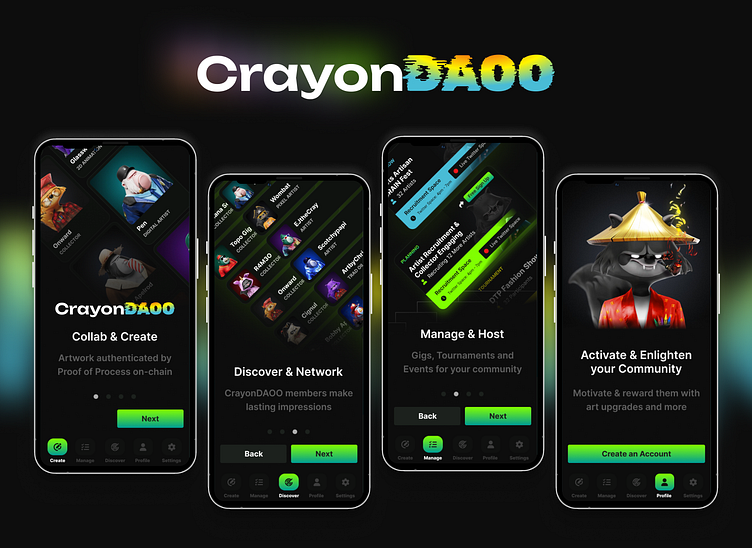CrayonDAOO Gig Marketplace
After extensive research and planning, CrayonDAOO Marketplace was created as the first DAO-funded community initiative. Special thanks to the Degenerate Trash Panda community on Solana for their support and inspiration.
Brand and Research
Thorough research is essential when entering a new field. After exploring various blockchains, I chose Solana for its speed and low fees. While sacrificing some factors like decentralization, I engaged with the community and focused on platforms like Twitter, Discord, and Telegram. Through these channels, I participated in discussions, events, and NFT activities.
I managed my risk by investing in assets with IP potential, particularly the Crayon Farmer DTP trait. Discovering the developer behind DTP, Jordan Prince (Pit the Panda), and their projects like the Candy Machine, Raindrop Protocol, and Cupcake Protocol, broadened my understanding of the field's future direction.
Community
To build great products, a Product Designer should understand their target audience. I did this by reviving my Twitter account and growing it as an NFT artist. Through networking, I connected with deejfit, an early adopter of Midjourney AI.
To engage the DAA and DTP communities, we collaborated on Degen Trash Lore, a series of AI/Procreate pieces. We airdropped these artworks to asset holders we admired or wanted to connect with. This collaboration strengthened our presence in the community, resulting in over 112 creations and 300 hours of free work. In just a month, my Twitter following grew from 7 to 2000.
My followers include notable individuals such as Solana's co-founders, Anatoly Yakovenko and Raj Gokal, as well as Austin Federa, the head of Strategy at Solana Foundation. Additionally, I connected with Pit the Panda (DTP Founder, Father of NFTs on Solana), Sea-Eoh (Former DAA CEO), and Armani Ferrante (Founder of xNFT Backpack and MadLads). Working pro bono in Web3 allowed me to interact with exceptional executives and engineers from around the world.
Degen Trash Lore
Each piece was chosen because it belongs to a builder or community member in the space we wanted to connect with. They all started as an original piece of art from Monoliff, was run through Midjourney with various prompts related to the holder, and then Photoshopped to bring back the detail from Mono's work that was left out. This three-part process was repeated 112 times over the span of a month and took a combined total of 300 hours on both our parts.
As you can see, it was a head-turner when displayed in the Solana Spaces physical location in LA. Solana Spaces has since pivoted to become DRiP. I highly recommend subscribing to their free art airdrops if you're new to Solana.
Checkout the collection here: https://exchange.art/series/Degen%20Trash%20Lore/nfts
User Flow and Design
The user flow in the CrayonDAOO app is represented by a web of lines, connecting different screens through universal navigation. The screens form a D shape, paying tribute to the Degen Trash Pandas and Degenerate Ape Academy communities.
The Smart Contracts
Raindrops protocol is a series of 5 contracts on Solana that enable games to store and access data on-chain. This allows games to share and trust data across a connected ecosystem of games, and to create new and exciting features.
A perfect example of a successful NFT project using Raindrop Protocol's smart contracts is Claynosaurz. Check out this video demonstrating the tech posted by @joel_cassady on Twitter. Give him a follow.
The Imperium of Rain DAO
The Imperium of RAIN DAO controls 51% of the total $RAIN supply, giving it the power to decide the projects it will support. Members can also submit proposals if they hold a minimum of five DTPs.
The Vote
I submitted three CrayonDAOO proposals for $RAIN tokens. Two of them passed, but the first one encountered a contract bug and didn't execute. After campaigning for weeks, I had to resubmit the proposal.
During the same week, the collapse of FTX and the industry led to an $8 SOL. Due to the significant drop in $RAIN token value (almost 97%), I canceled my second proposal and requested 36.9M $RAIN instead of the initial 4.15M in a vesting contract. The revised proposal passed with a vote of 1045 to 126, two months after the first proposal. It was time to start working.
The purpose of CrayonDAOO
CrayonDAOO addresses trust, volatility, misinformation, and UX issues in Web3. It enables collaboration and on-chain proof of process for Creators and Collectors. This helps differentiate real creators from AI-driven bots.
By incentivizing transparency and accountability, it builds confidence for Collectors and project founders seeking Artists.
In Web2, this concept aligns with Competitive Intelligence (CI), a growing $28.90 billion market. While AI assists in aggregating data, people remain the creators and prefer transacting with humans, not AI or robots.
Proof of Process
In CrayonDAOO Gigs, both Creators and Collectors submit Process and Review Tokens as NFTs to track work in progress. Creators send Process Tokens, Collectors send Review Tokens.
When a Gig is completed, Watermark Tokens are burned to authenticate the final piece. This data helps identify reliable Creators and problematic Collectors and analyze interactions and influence within the ecosystem.
Event Creation and Management
Apart from artwork creation, CrayonDAOO focuses on creating, hosting, and managing live events. Artists can submit their work through a universal Event Landing Page, attracting collectors and spectators.
Here's a demo!
Be aware it's only a Figma prototype. The actual app is still in development. CrayonDAOO doesn't have anything for sale so stay safe and dodge the scams.
Don't want to scroll? Tap Z on your keyboard to Fit to Screen.
Future Plans and Contact
While the future of the industry is uncertain, I intend to continue participating in the community. This project has provided valuable experience and relationships. I am open to opportunities and can be reached on Twitter at @HANS_SOL_OG or via email at CrayHansSolo@gmail.com.
Thank you for your time!






































